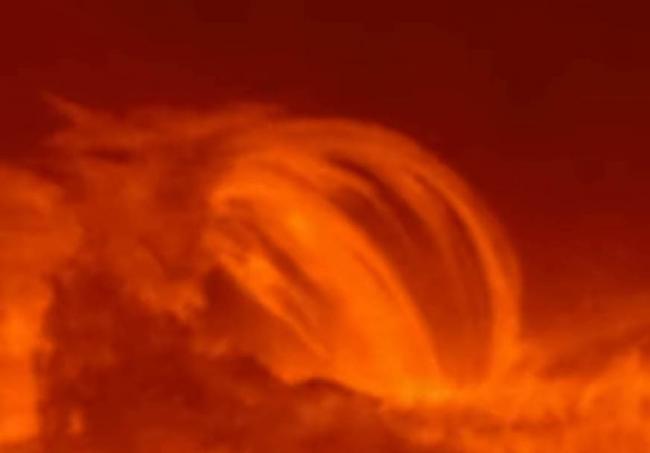
An ultraviolet image of a loop-like coronal arc in the Sun. Astronomers discovered nanojet clusters along the arc material and show that they are the basis for the long-sought-for nanoflares thought to heat the corona to its million-degree temperature.
The solar corona, the hot outer layer of the Sun, has a temperature of over a million degrees Kelvin and powers a wind of charged particles, some of which bombard the Earth producing auroral glows and often disrupting global communications. These properties of the corona are poorly understood, but astronomers have hypothesized that the heating is due to a myriad of tiny magnetic energy outbursts, called nanoflares, that result when the strong magnetic field lines in the corona (primarily the result of the motions of charged particles below the solar surface) break and reconnect. However, no direct observations of nanoflares exist and this lack has cast doubt on the proffered solutions to the coronal heating problem.
The technical issues are three-fold. First, although some ultraviolet satellites have seen some small intensity bursts in the nanoflare range, and X-ray observations of coronal magnetic loops have detected heating activity, none of these has been unequivocally linked to magnetic reconnection, the originally proposed mechanism for nanoflares. In fact many scientists thought any such linkage would be difficult to prove because the sizes of nanoflares are so small. Finally, numerical modeling of coronal heating has found that some nanoflare-like intensity bursts could be produced in non-reconnection events, like wave heating, forcing any observational diagnostics to discriminate between these alternative mechanisms at very small scales. Instead, astronomers have focused on large-scale changes in the magnetic field or other processes to study magnetic reconnection.
A collection of reconnection-based nanoflares, known as a nanoflare storm, could provide substantial coronal heating if suitably triggered by magnetic fields. CfA astrophysicist Paola Testa and her colleagues now report on the discovery of very fast, bursty nanojets which they argue are the signatures of a nanoflare storm responsible for coronal heating. The scientists used the Atmospheric Imaging Assembly of the Solar Dynamics Observatory, the Interface Region Imaging Spectrograph, and the Hinode/Solar Optical Telescope in observations from 2014 targeting a loop-like structure in the corona that was seen from a sideways angle able to watch material flowing along strands of the loops.
At the end of an hours-long observation, the astronomers spotted about 150 small, localized intensity bursts and jet-like structures during a thirteen minute period. They identify them as nanojets; each one lasted under fifteen seconds. Several of them were also analyzed by the spectrograph and found to have magnesium and silicon emission from atoms moving faster than one hundred km/sec, among the other properties expected for nanojets. The team corroborated their nanojet diagnosis with a model of the behavior of reconnecting magnetic flux tubes. The new result not only confirms the long-anticipated mechanism of nanoflares for coronal heating, but adds many unanticipated insights including the discrete, distinct nature of the nanojets.
Reference(s):
"Reconnection Nanojets in the Solar Corona," Patrick Antolin, Paolo Pagano, Paola Testa, Antonino Petralia, Fabio Reale, Nature Astronomy online, s41550-020-1199-8, 2020.